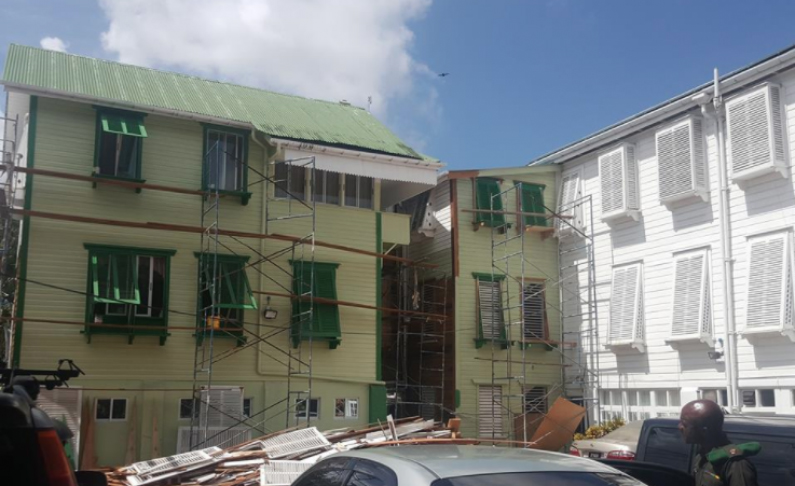Although President David Granger has insisted that no laws were broken in the undertaking of renovations to State House, a national monument, without the permission of the National Trust, the National Trust Act clearly states that failure to first get written consent from the body attracts a minimum penalty of a fine.
“Any person who disturbs, removes, undermines, defaces or in any manner damages or interferes with any national monument or anything therein or thereupon otherwise than in accordance with the written permission of the National Trust is liable on summary conviction to a fine of one hundred and thirty thousand dollars, and in those proceedings the court may, in addition, order him to pay such sum as the court thinks just for the purpose of repairing or restoring the monument,” Section 17 of the National Trust Act states.
The Act makes provision for the preservation of monuments, sites, places and objects of historic interest or national importance.
“I am not aware that a law has been broken… I am not aware that in fact National Trust needs to worry about the present decision to ensure that State House is in good repair… it doesn’t leak,” Granger said on Wednesday, shortly after an accreditation ceremony at State House.
It was revealed last week that the Trust, which has overall responsibility for State House, one of nine gazetted national monuments in Guyana, was not notified of the ongoing renovations.
Nirvana Persaud, the Trust’s Chief Executive Officer, had previously stated that the Trust was never officially told about any repairs but because of the close proximity of its offices to State House, it noticed the works.
Persaud had explained that the Trust is supposed to be informed about any plans to repair a heritage site. “We weren’t informed at all…,” she said before making it clear that the Trust has no problem with the repairs being done. “We welcome any historic property being repaired but recently ….we noticed they changed the colour… major changes, such as the colour and repairs, generally once it involves changes, ought to be communicated to us and discussed so that we are all on the same page. I know the president and us, we are for preservation,” she said.
Persaud had informed that she has noticed that more windows on the building have also been replaced with modern ones.
“It is a national monument under the National Trust law, so for that reason it should have been communicated. Maybe it was an oversight,” she added.
According to Granger’s explanation, the decision was taken to undertake repairs because of rotting wood and dilapidated windows. However in addition to the replacement of the wood and windows, the building, which was originally white, is being repainted. It is the entire building and not only the repaired section that is being repainted.
The installation of modern windows, which alters the original architecture of the building, has also been highlighted.
“We have heritage buildings all around the country. Some of them are collapsing. I weep when I see the condition of City Hall, St. George’s Cathedral and I am very concerned about preserving heritage. That’s why I’m repairing State House,” Granger told reporters.
He noted that the building was constructed in 1854 and “there is a lot of rot. Some of the windows were falling off and a decision was taken to repair the rotting portions and to repaint it.”
Observers have noted that it was not first a question of whether any law had been broken but about protocol and procedure not only as it pertains to the repairs but the repainting.
The green paint has a broader context as it has been seen as a deliberate attempt by the government to perpetuate the predominant colour of the governing coalition. Green is also associated with A Partnership for National Unity and the People’s National Congress Reform, both of which are led by Granger. The Ministry of the Presidency is also being painted in the same green even though this had not been the original colour. At one point, canary yellow had also been introduced in the colour scheme of the Ministry of the Presidency but it was painted over. Yellow is the predominant colour of the other member of the governing coalition, the AFC. Weeks after winning the 2015 general election, green and yellow paint began appearing on a range of items in public places and this attracted criticisms.
When asked if State House was “going green,” given the new colour of the building, Granger had responded “Guyana is going green.”
Persaud, while informing that the repair works are welcomed, had told Stabroek News last week that any major works, including repairs and repainting, must be communicated to the Trust. As a result, she said a letter would be penned to the Ministry of the Presidency (MoTP) about the matter.
During a post-Cabinet press briefing yesterday, Minister of State Joseph Harmon confirmed that the Permanent Secretary of the Ministry of the Presidency did receive a letter from the National Trust. Noting that the president has given a “wholesome” answer to the issue the day before, he said that the National Trust will get a response to the letter “in due course and they will have all of the reasons in the response.”
Pressed on what some of the reasons will be, he said, “I can’t tell you all of that now but when the National Trust gets their response, I think that that information will be made public.”
State House under repair and being repainted









